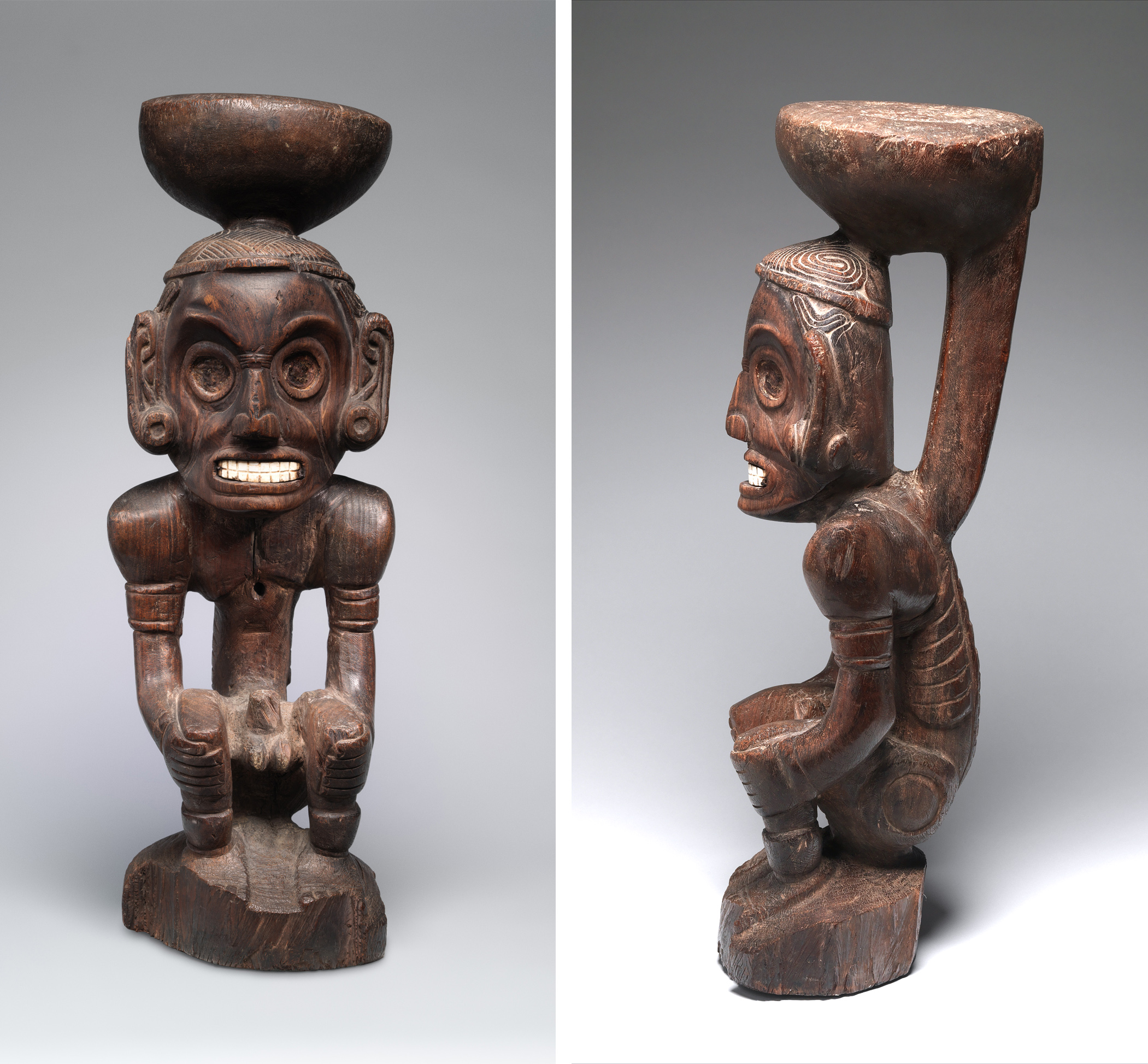
Taíno artist, Zemí, c. 1000, wood and shell, from the Dominican Republic (The Metropolitan Museum of Art)
An emaciated figure looks out at us, his teeth bared and his eyes wide open. A large bowl rests atop his head. This figure, known as a zemí (or cemí), shows someone who has likely fasted for days in preparation for a ritual, which involved snuffing cohoba (a type of hallucinogen). Ingesting such substances would allow the participants, typically spiritual healers or caciques (rulers), to travel to the world of the spirits and communicate with them, bringing power and healing knowledge back to their people. The bowl atop the zemí would have been used for this very ritual, while his alert facial expression would have echoed that of its practitioner.
The side view of the zemí shows his lean state, with his ribs emphasized in low relief. He wears a woven cap, ear ornaments, and around his biceps and ankles are bands referred to as ligatures—tightly-bound ornaments that often pinched the flesh and modified the shape of the arm or leg they adorned. While now appearing nude, the figure may once have worn a loincloth.[1] Although only the teeth remain of its shell inlay, the zemí would originally have had inlaid eyes as well. The grimacing mouth and open, staring eyes are characteristic of cohoba users, and so may be meant to show the zemí in a trance state.
While many zemís, were used as cohoba stands, the word “zemí” in the Taíno language refers to “a spiritual and vital force pertaining to deities and ancestors;”[2] meaning that zemís were also imbued with spiritual, ancestral, and supernatural forces. Art historian James Doyle explains this process further:
Sculptures began with a call from the medium itself; for example, a tree would frighten a person walking through the forest by moving its roots. The person would ask the tree spirit (zemí ) who it was, and the spirit would demand that a ritual specialist reveal its identity. When the ritual specialist arrived, the spirit’s specific bodily form would be revealed during a hallucinatory trance. Once the identity became known, an artist would sculpt the tree (or stone) invested with divine power into a figure. James A. Doyle, “Arte del Mar,” 23.
As objects used for both ritual and veneration, zemís could impact many aspects of Taíno life, influencing the health, social standing, political power, or the fertility of an individual.
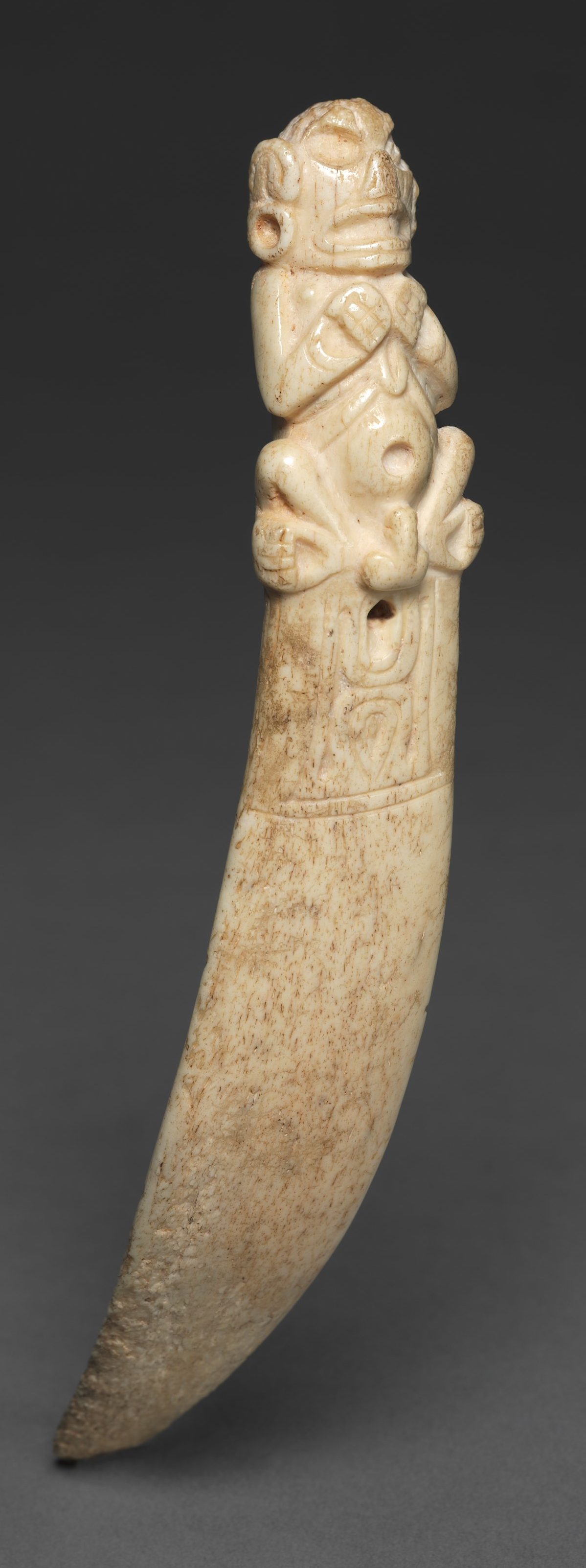
Taíno artist, Spatula, c. 10th–15th century, manatee bone, from the Greater Antilles, Caribbean (Cleveland Museum of Art)
The ritual of sniffing cohoba
The ritual of sniffing cohoba began with a cleansing process, through which the cacique would induce vomiting. Afterwards, the cacique would use a spoon to place the cohoba on top of the zemí. With the aid of tubes, the cacique would sniff the cohoba, which was sometimes mixed with tobacco or crushed seashell to enhance the hallucinogenic effects. Taíno artists made objects specifically for this ceremony, such as spatulas to capture the snuff and sticks to induce vomiting.
The experience of sniffing cohoba was an all-body experience through which caciques interacted with the supernatural world and interpreted these induced apparitions as communications with either gods or ancestors. The knowledge acquired from interactions with the spirits was fateful for the sick since the cause of illness, and its cure, could be ascertained.
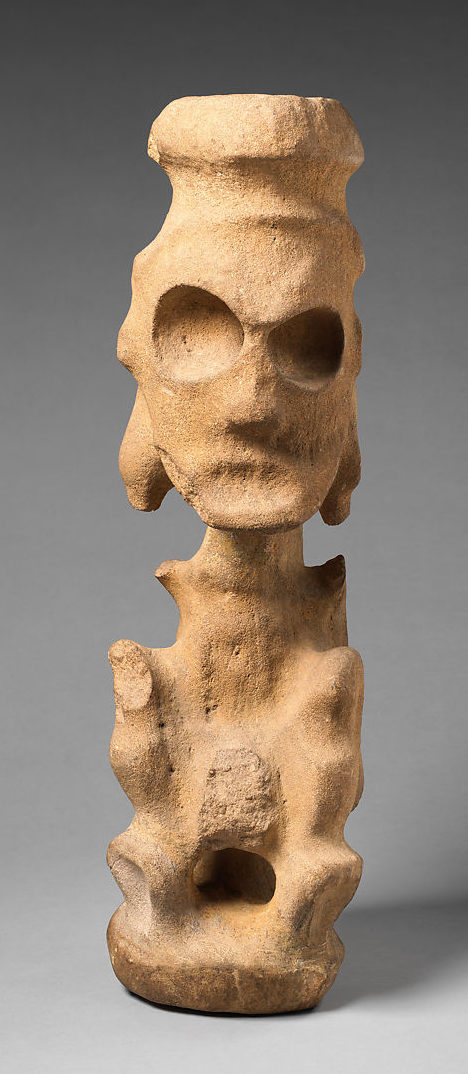
Taíno, Deity Figure (Zemí), 13th–15th century, sandstone, Dominican Republic (The Metropolitan Museum of Art)
Materials
The material from which the zemís were made significantly affected the style of the finished product. In the case of a zemí made of sandstone, one can see how the smooth edges and round features of the cohoba stand echo the circular eyes and oval mouth of the figure. Depicting a crouched figure, which is typical of cohoba stands, the body’s features seem to blend in and at times disappear altogether with the cylindrical shape of the stand, perhaps a consequence of its material fragility.
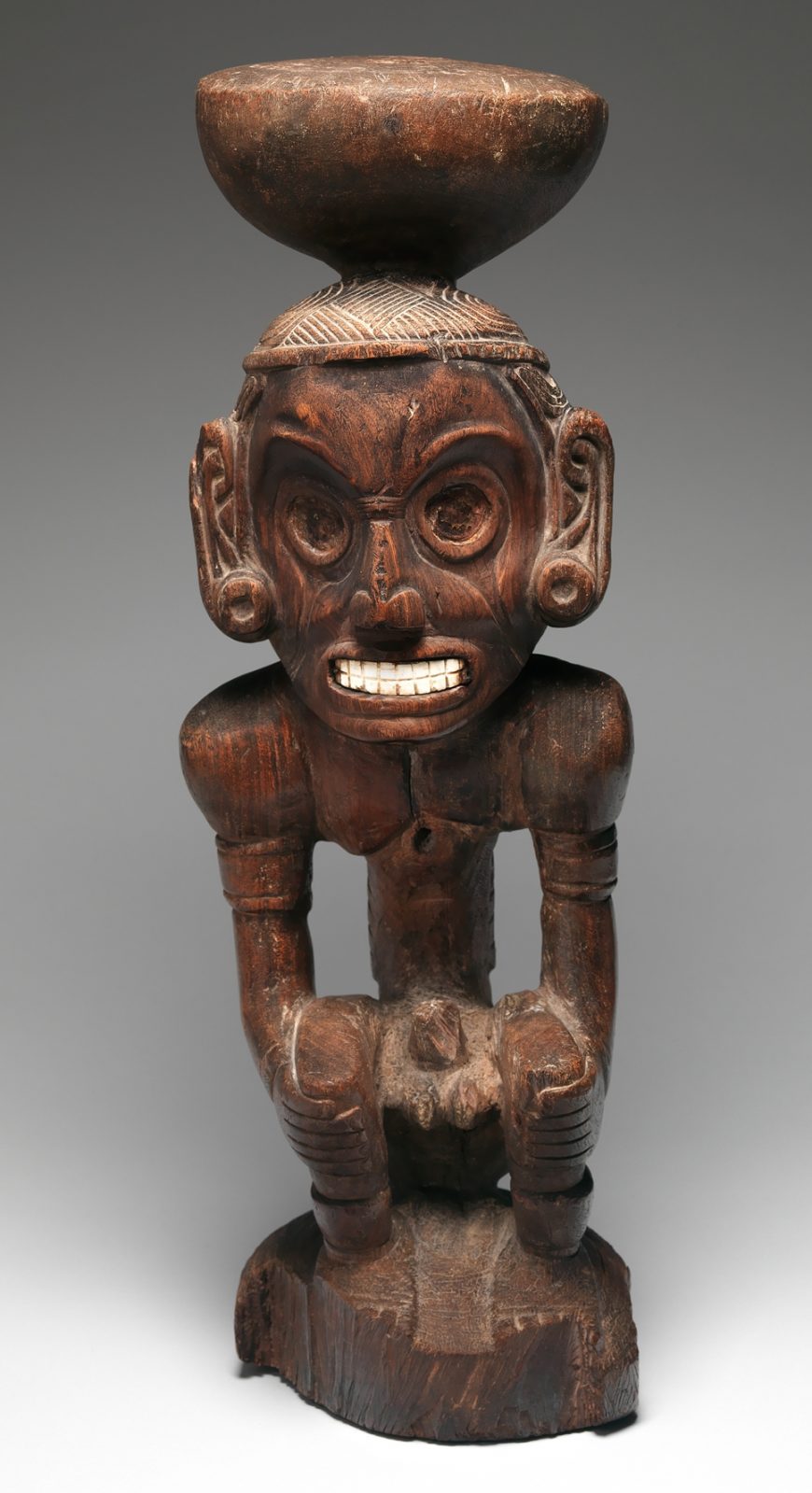
Deity Figure (Zemi), c. 1000, Dominican Republic, wood, shell, 68.5 x 21.9 x 23.2 cm (The Metropolitan Museum of Art)
By contrast, the wooden zemí is more detailed, as seen through his descriptive face and emaciated body. The detailed face, which depicts a crying figure, allows us to identify the zemí as a depiction of Boinayel, the Rain Giver. The white teeth, made of shell, add a strong decorative element to this already intricate figure. Together, the use of low relief carving and inlaid material give this zemí a heightened sense of realism, not seen in the stone zemí.
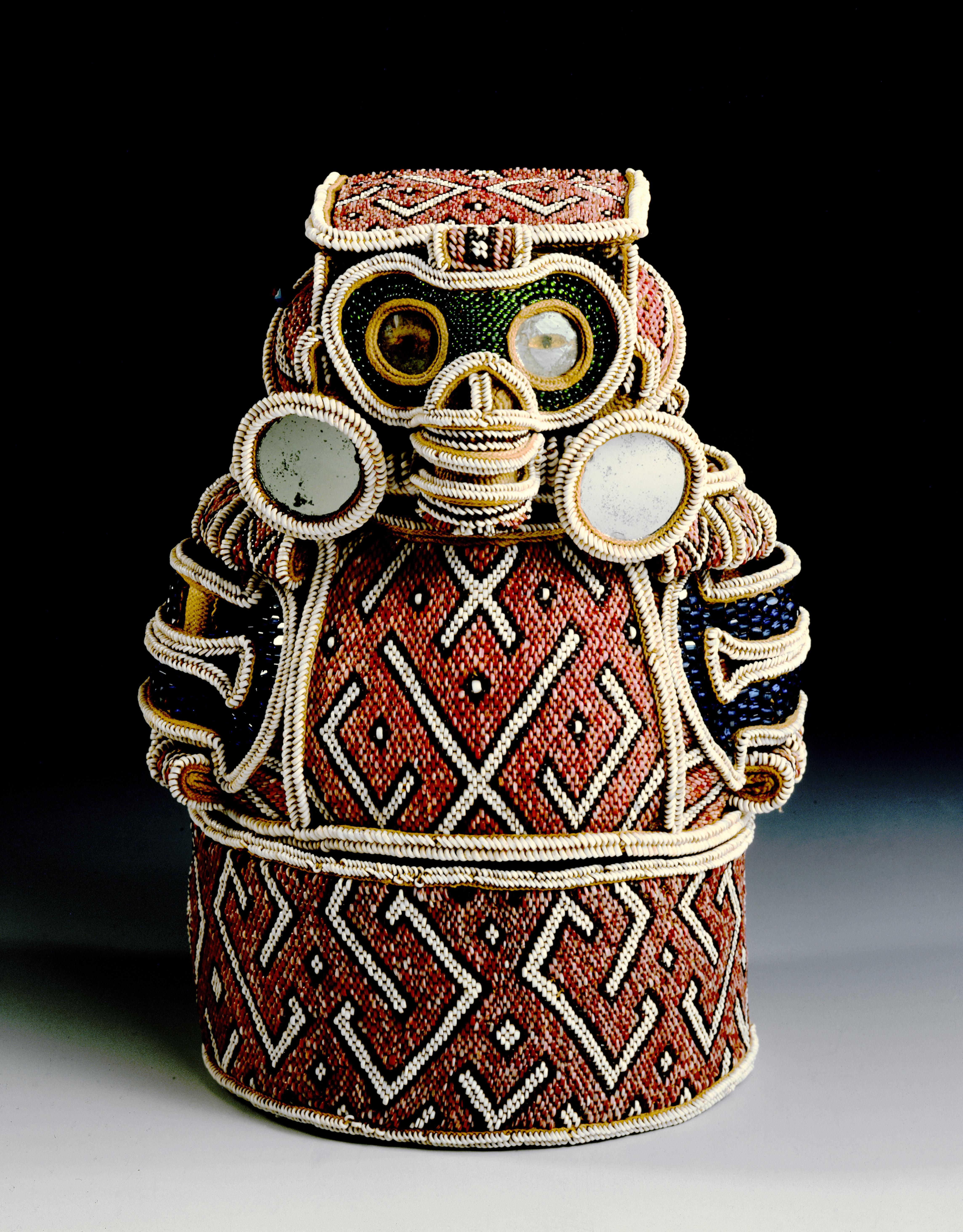
Taíno artist, Zemí (mask side), c. 1510–1515 (Museo Nazionale Prehistorico ed Etnografico “Luigi Pigorini,” Rome, Italy; photo: Lorenzo Demasi)
Who made this Zemi?
The Pigorini Museum in Rome, Italy, display a zemí that has baffled visitors and art historians alike. Lavishly decorated with seashells, glass beads, and mirrors, this zemí features the depiction of a cacique on the front and a zoomorphic mask on the back. The dualism of this zemí and the use of these particular materials and style are rarely found in Taíno art.
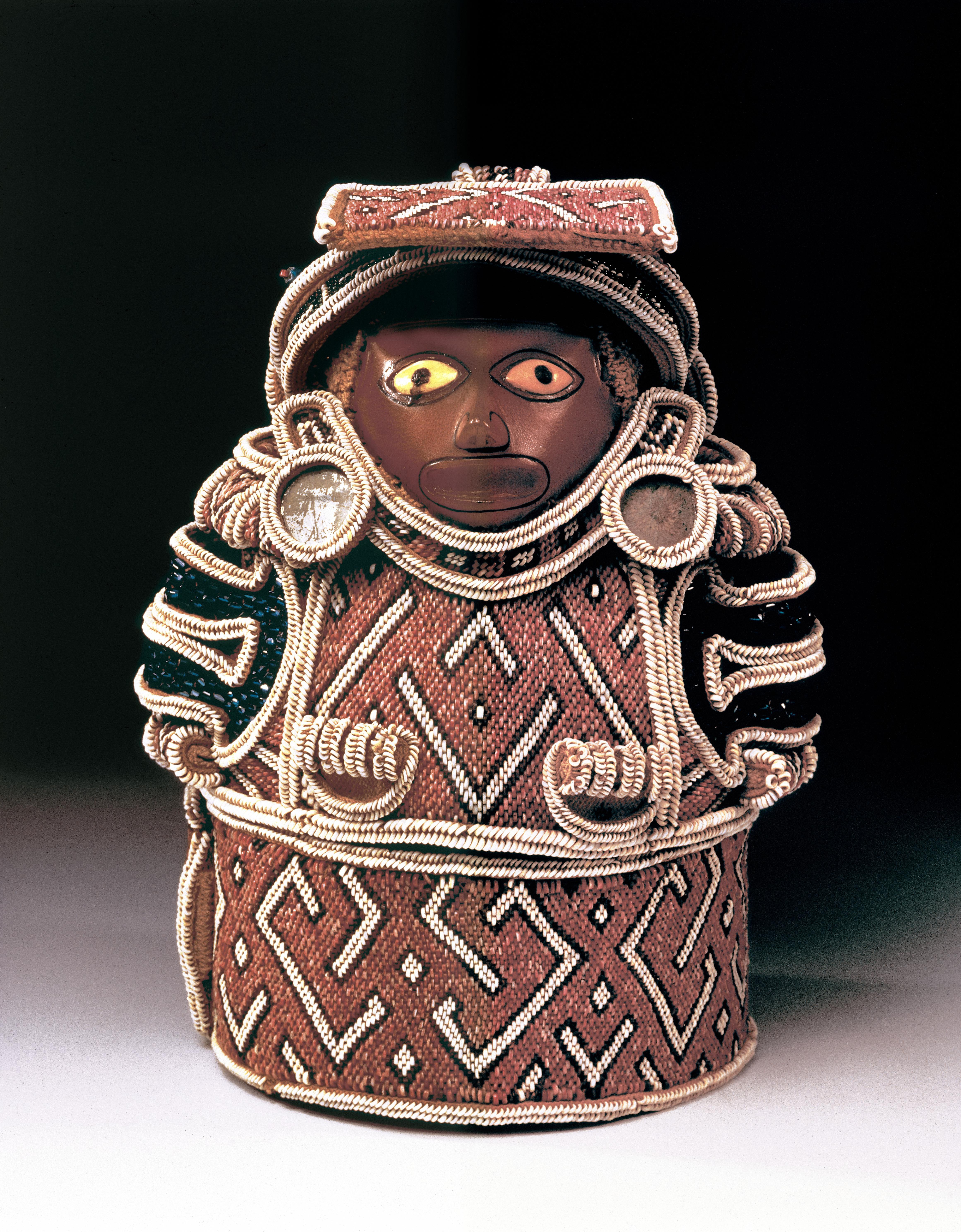
Taíno artist, Zemí (cacique side), c. 1510–1515 (Museo Nazionale Prehistorico ed Etnografico “Luigi Pigorini,” Rome, Italy; photo: Lorenzo Demasi)
Because the human face is carved from West African rhinoceros horn and the beaded designs seem to mimic the complex geometric arrangements found in Angolan art, viewers may wonder whether the artist of this unique zemí was West African or Caribbean. Making the matter more complex is the use of Venetian mirrors to create the eyes and ears of the zoomorphic mask and Venetian glass beads to decorate the exterior. How did Taíno artists have access to these materials, designs, and iconography? Or was the artist even Taíno?
The Beaded Zemí looks similar in many ways to other Taíno zemís including the typical gaping eyes, wide-open mouth, and squatting position. There are more differences though. The variety of materials, many of which are rare, and use of geometric design dramatically depart from the simplicity encountered in traditional zemís. Art historians have explained the dualism of this zemí as the transformation of a ritual specialist, with the human face being a reference to human life, and the mask, which many believe to be skeletal, a reference to death. Nevertheless, even if the zemí does not depict a ritual specialist, it may still relate to cohoba rituals through its associations with the spiritual world of the dead. And at least in that regard, it is a clear example of Taíno art.
The confluence of European and African influences have led scholars to think that the Beaded Zemí was made sometime between the initial Spanish colonization of the Caribbean and the Taíno demographic decline during the mid-sixteenth century. It is a unique artwork. The Beaded Zemí reveals the high-level cultural complexity that resulted from the colonization of Latin America.
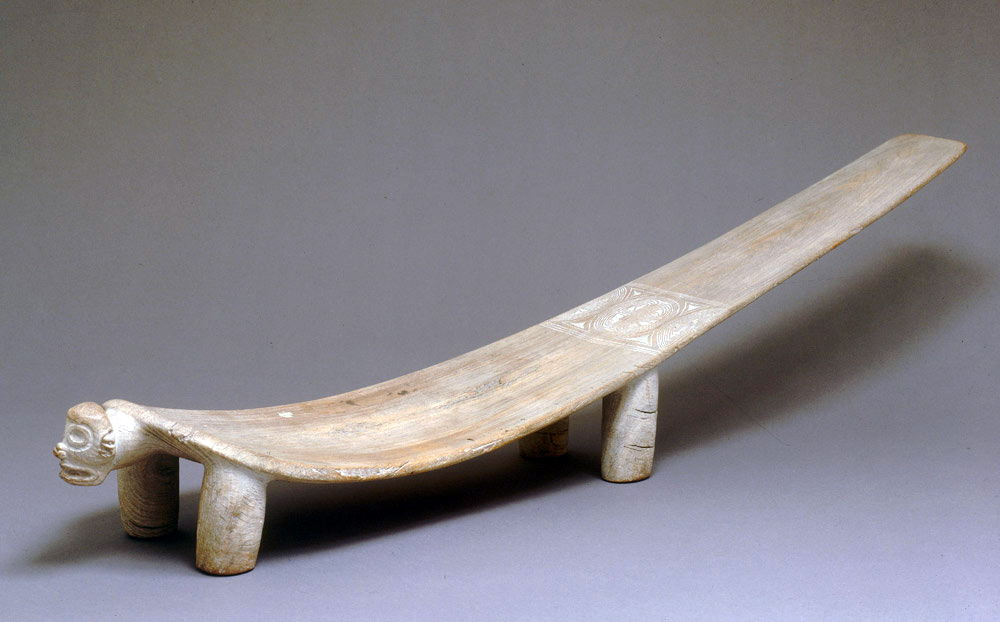
Lucayan duho (seat), high-back style, 1000–1500, wood, 84 x 15 x 21 cm, Turks and Caicos Islands, Bahamas (National Museum of the American Indian)
Duhos
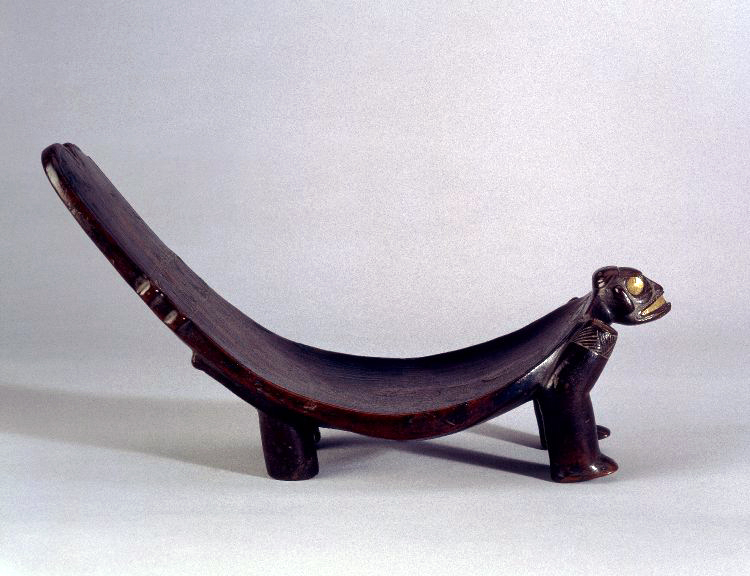
Taíno artist, Duho, 1292–1399, wood and gold, 44 x 22 x 16.5 cm (The British Museum)
Duhos are ceremonial seats fashioned out of stone or wood. They symbolized prestige and power since only caciques or ritual specialists used them. While duhos ranged in design, consisting of high-back or flat seats, they were most commonly low seats supported by four legs. Despite being seats of power, much like what we would today call a throne, duhos were low to the ground, featured no arm rest, and their reclining position resembled that of hammocks.
Duhos from the Dominican Republic were usually highly ornate, featuring decorative patterns and exotic materials, such as manatee bone and gold. The backrest was an essential part of the seat since it provided lumbar support to the cacique or ritual specialist during rituals. The head, featured prominently in the front, and stylistically in keeping with zemi sculptures, depicted either a god or ancestor. The smooth wooden surface would have made the experience all the more comfortable, allowing the cacique or ritual specialist to relax as he mentally entered the spiritual world.
Ranging in color and graining pattern, wooden duhos reveal the diversity of Caribbean timber and might for instance be made of the tropical hardwood Guayacan, which the Taíno valued for its dark color and glossy finish. Further contributing to its shimmering effects, the artist decorated this duho with gold sheets that have been inserted into the eyes, mouth, earspools, and joints of the figure. Despite the perishable nature of wooden duhos, they have survived in large part because the Taíno stored them in caves to protect them from humidity and fire, as well as from invading Spaniards. It is extraordinary that any of these fragile ceremonial seats have remained almost intact. Used not only in cohoba sniffing rituals, duhos were also placed inside tombs, where they rested alongside the interred cacique.
Notes:
- James A. Doyle, “Arte del Mar: Art of the Early Caribbean,” The Metropolitan Museum of Art Bulletin vol. 77, no. 3 (Winter, 2020), 23.
- Ibid., 24.
Additional Resources:
Doyle, James. “Indigenous Arts of the Caribbean.” In Heilbrunn Timeline of Art History. New York: The Metropolitan Museum of Art, 2000–. (June 2021)
James A. Doyle, “Arte del Mar: Art of the Early Caribbean,” The Metropolitan Museum of Art Bulletin vol. 77, no. 3 (Winter, 2020)
Lawrence Waldron, Pre-Columbian Art of the Caribbean (University of Florida Press, 2019)
Taino: Pre-Columbian Art and Culture from the Caribbean, ed. Fatima Brecht, Brooklyn Museum, NY, 1997

